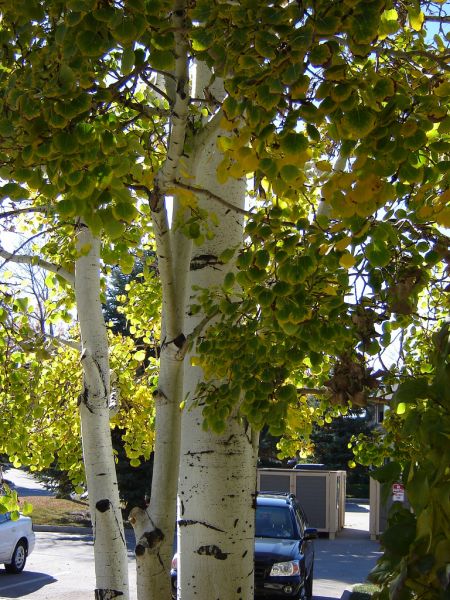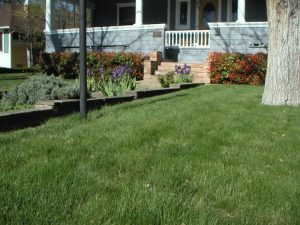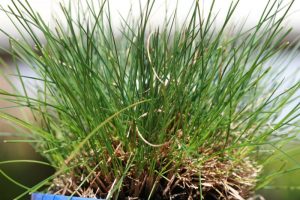 “H-O-T” is the only word to describe our homes’ west walls during the afternoon hours in Arizona! That baking sun can roast western walls and send air conditioning bills skyrocketing. Best at coping with a western exposure are tall deciduous trees. Every spring, their fresh new leaves create much-needed shade from that afternoon fireball. Because they lose their leaves in fall, their bare branches allow penetration of winter’s sun to warm that side of a house.
“H-O-T” is the only word to describe our homes’ west walls during the afternoon hours in Arizona! That baking sun can roast western walls and send air conditioning bills skyrocketing. Best at coping with a western exposure are tall deciduous trees. Every spring, their fresh new leaves create much-needed shade from that afternoon fireball. Because they lose their leaves in fall, their bare branches allow penetration of winter’s sun to warm that side of a house.
Quaking aspens have a tall columnar form that provides good shade in small backyards or between homes at the edge of property lines, especially where that hot western sun bakes exterior walls. Aspens effectively shade walls and patios from a western exposure, and eventually grow tall enough to shade second story decks. A valuable characteristic of aspens is that after several years they don’t take over the yard like so many other fast-growing trees.
With their famous “quaking leaves”, aspens animate windy hilltops. The slightest breeze causes the leaves to “dance”, their moving and swirling adding another dimension to the landscape that is unique to our mountain areas.
The Arizona variety of aspen is tall and narrow, perfect for framing vistas. I like placing aspens at decks and patios, using them as picture frames to guide the eye towards the perfect sunset, a mountain peak, or down toward a meadow view.
The garden center is stocking up with aspens, easily identified by their fall colors of harvest gold leaves and paper white bark. If you want to plant a really tall aspen, now through October is the best time to find the largest sizes. I have several spectacular aspens in stock, some taller than the peaks of our tallest greenhouse!
To reduce transplant shock, some garden writers suggest planting aspens in autumn right after the leaves have fallen. I prefer to plant them while the monsoon season still delivers its liquid bounty as rains increase planting success. Whether planted when the leaves are still green or after leaf drop, the landscape can enjoy established golden autumn colors through October.
~ * ~
September is the month to install a new lawn, extend an existing one, or over seed an old and tired lawn. Whether you install grass by seed or sod, success hinges on your preparation of the soil.
 Remove rocks and kill the weeds in the area where you want to put your lawn. Remove any large dirt clods and correct any irregularities in the grade. Add about 2″ of mulch to the soil and turn to a depth of 6 inches. Settle the area with a roller or a heavy application of water. Never plant grass seed on “fluffy” soil or you will end up with an uneven, rolling lawn. Rake, or “scarify”, the settled surface to form a loosened seedbed.
Remove rocks and kill the weeds in the area where you want to put your lawn. Remove any large dirt clods and correct any irregularities in the grade. Add about 2″ of mulch to the soil and turn to a depth of 6 inches. Settle the area with a roller or a heavy application of water. Never plant grass seed on “fluffy” soil or you will end up with an uneven, rolling lawn. Rake, or “scarify”, the settled surface to form a loosened seedbed.
Apply Soil Activator and my specially blended “All Purpose Plant Food” 7-4-4 over the raked seedbed. Soil Activator stimulates deep roots; the plant food promotes fast development of those luscious green blades. Now you are ready to spread seed.
There are two varieties of grass that hold their green through winter. One is called the “Sun Loving Mix”, a blend of perennial rye and blue grass. The rich green color is soft to look at and even softer underfoot. While this old-time favorite grass is the one for lawns seen in photographs and magazine covers, its negative aspect is the considerable amount of water it requires.
 Fescue is the second and tougher of the two grass varieties that do well in our area. It is deep-rooted and requires far less water. It bounces back from the heavy traffic and daily abuse from kids and dogs. I know because this is the lawn I’ve chosen for our homes, and it has stood up to heavy use every time. Fescue has a wide yet soft blade, and it has a nice clean look after mowing. Irrigate no more than about twice a week even during the hottest days in June.
Fescue is the second and tougher of the two grass varieties that do well in our area. It is deep-rooted and requires far less water. It bounces back from the heavy traffic and daily abuse from kids and dogs. I know because this is the lawn I’ve chosen for our homes, and it has stood up to heavy use every time. Fescue has a wide yet soft blade, and it has a nice clean look after mowing. Irrigate no more than about twice a week even during the hottest days in June.
For over-seeding do not spread grass seed directly onto thatchy areas; the seeds will float and never get a taproot down into the soil. Instead, rake out the existing lawn’s dead thatch areas to expose the soil beneath. Sowing on bare soil gives the seed a place to germinate.
Roll the entire surface to press the soil around the seed or apply another heavy application of water. Cover the seeded bed with a light layer of mulch. This will regulate moisture, temperature, and keep the birds from dining on the seed. Right now our weather is so nice that the seed will germinate within days. Keep the seedbed moist throughout the germination period.
Until next week, I’ll see you at Watters Garden Center.
Ken Lain can be found throughout the week at Watters Garden Center, 1815 W. Iron Springs Rd in Prescott, or contacted through his website, Watters Garden Center, or Watters FaceBook page.

